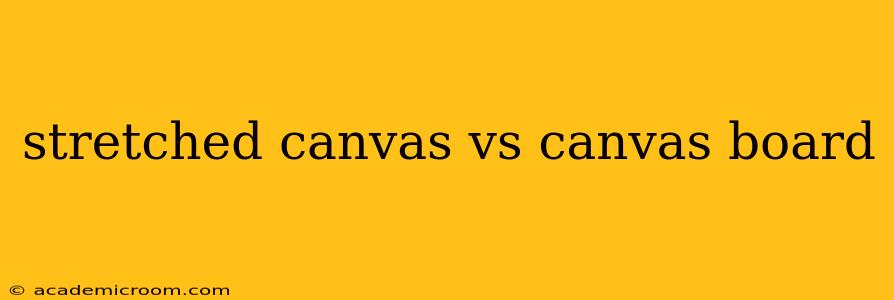Choosing the right painting surface can significantly impact your artistic process and the longevity of your artwork. Two popular options are stretched canvas and canvas board. Both offer a canvas texture for painting, but they have key differences that make them suitable for different purposes and skill levels. This guide will help you understand the pros and cons of each, enabling you to make an informed decision.
What is a Stretched Canvas?
A stretched canvas is a piece of cotton or linen canvas fabric stretched taut over a wooden frame (stretcher bars). The fabric is secured to the frame using staples or tacks, creating a rigid, ready-to-paint surface. Stretched canvases are available in various sizes and depths (the thickness of the frame).
Pros of Using a Stretched Canvas:
- Professional Look and Feel: Stretched canvases provide a classic, professional presentation for artwork, suitable for framing or displaying without additional support.
- Durability and Longevity: The sturdy frame protects the canvas, preventing warping and ensuring the artwork lasts for years.
- Versatility: Stretched canvases accommodate various painting techniques, including layering, impasto (thick application of paint), and heavy textures.
- Ease of Handling: The rigid frame makes it easy to handle the canvas during painting and transportation.
Cons of Using a Stretched Canvas:
- Higher Cost: Stretched canvases are generally more expensive than canvas boards.
- Storage Considerations: Due to their size and rigidity, stretched canvases require more storage space.
- Potential for Damage: While durable, stretched canvases can be damaged if dropped or mishandled.
What is a Canvas Board?
A canvas board consists of a canvas fabric glued to a stiff board, typically made of cardboard or MDF (medium-density fiberboard). This creates a lightweight, ready-to-paint surface.
Pros of Using a Canvas Board:
- Affordability: Canvas boards are significantly cheaper than stretched canvases, making them ideal for practice, experimentation, and students.
- Portability: Their lightweight and compact nature makes them easy to transport and store.
- Ease of Use: No preparation is needed; simply begin painting.
- Suitable for Small Works: Excellent for smaller paintings, studies, or quick sketches.
Cons of Using a Canvas Board:
- Less Durable: Canvas boards are less durable than stretched canvases and prone to warping, especially with thicker paint applications or exposure to humidity.
- Limited Versatility: The thinness of the board may not support heavy layering or impasto techniques.
- Less Professional Appearance: The thin board might not offer the same professional look and feel as a stretched canvas.
- Can Buckle Under Wet Paint: The board can warp if too much wet paint is applied at once.
Which is Right for You?
The choice between stretched canvas and canvas board depends on your needs and preferences:
-
Beginners and Students: Canvas boards are a great starting point due to their affordability and ease of use. They allow for practice and experimentation without significant investment.
-
Experienced Artists: Stretched canvases are preferred by professionals for their durability, versatility, and professional presentation. They are ideal for larger works and pieces intended for exhibition or sale.
-
Small Projects: Canvas boards are suitable for small projects, quick studies, or sketches.
-
Large or Detailed Works: Stretched canvases are better for larger paintings and works requiring heavy layering or impasto techniques.
How Do I Prepare a Stretched Canvas?
While stretched canvases are ready-to-paint, some artists prefer to prime them with gesso. Gesso is a primer that seals the canvas, creating a smooth surface and enhancing paint adhesion. This step is optional but recommended, particularly for beginners, to ensure better paint application and prevent the canvas from absorbing the paint too quickly.
Can I Use Acrylics on Canvas Board?
Yes, acrylics work well on canvas board. However, remember the limitations of the board's thickness and its susceptibility to warping. Apply paint in thin layers and allow each layer to dry completely before applying the next to minimize the risk of warping.
What About Oil Painting on Canvas Board?
Oil paints are heavier than acrylics and can lead to warping on a canvas board. Using a thicker board may alleviate some of the warping, but stretched canvas is usually the preferred surface for oil painting due to its superior support.
By understanding the unique characteristics of stretched canvas and canvas board, you can choose the ideal painting surface that perfectly suits your artistic vision and skill level. Remember to consider your budget, project size, and painting style when making your decision.
